Functional and radiological outcomes of different pin configuration for displaced pediatric supracondylar humeral fracture:A retrospective cohort study
INTRODUCTION
A supracondylar humeral fracture happens through the thin part of the distal humerus above the growth plate level.These fractures are typical pediatric injuries,accounting for 60% of upper limb fractures and 13% of pediatric fractures.They are most commonly seen in children 5-7 years of age with no gender predilection[1-3].
These fractures may be complete or incomplete with varying degrees of severity.The Gartland classification system is a popular system for the evaluation and treatment of these fractures.It classifies them as type 1 - nondisplaced or minimally displaced,type 2 - displaced with intact posterior cortex,and type 3 - completely displaced without contact between fragments[3].In addition,the modified Gartland classification is frequently used,describing one more type,type 4 - complete multidirectional displacement of fragments with periosteal disruption[4].
As for the management of these fractures,a trial of conservative management may be undertaken with type 1 fractures and minimally displaced type 2 fractures.This involves long arm casting with less than 90 degrees of elbow flexion[5].
I come from the Tsardom of Tsar Vyslav, replied Tsarevitch Ivan, whose son I am, and my name is Ivan. Tsar Dolmat laid upon me this service, that I bring him the Horse with the Golden Mane, which thy father promised him and which is his by right.
Operative management is almost always required in more severe types,including closed reduction and percutaneous pinning(CRPP).Pinning is performed retrogradely,using two pins for type 2 fractures and three pins for type 3 fractures.Rarely,open reduction with percutaneous pinning is needed in open fractures and in cases of failed closed reduction[6].The most commonly reported postoperative complication is pin migration[7].
Despite reported complications of neurovascular injuries[8],it has been well documented in the previous literature that pediatric supracondylar humerus fractures generally have good outcomes.Elbow range of motion(ROM)and function are usually preserved,provided that adequate reduction is achieved through surgical intervention or casts application[9].
Well, said the old witch, only remember that every question does not lead to good. If thou knowest overmuch, thou wilt grow old too soon. What wilt thou ask?
CRPP has two techniques:Lateral pinning technique(Figure 1A)and cross pinning technique(Figure 1B).Controversy persists between the two perspectives regarding which is better in terms of fixation stability and risk of developing complications.
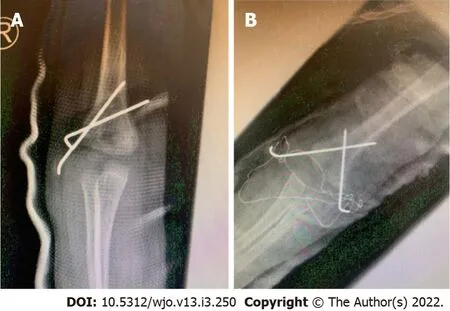
Theoretically,crossed pinning is superior in providing biomechanical stability,yet this construct increases the risk of iatrogenic ulnar nerve injury due to the medial pin position.Conversely,lateral pinning may be less stable biomechanically but avoids ulnar nerve injury[10-12].
Therefore,this study aimed to study the difference in stability and functional outcomes between patients managed by lateral pinning and those managed by crossed pinning for displaced supracondylar fracture of the humerus.The null hypothesis was that there is no difference between the treatment groups.
When something like a black cloud passed between her and them, she knew that it was either a whale swimming over her head, or a ship full of human beings, who never imagined that a pretty little mermaid10 was standing22 beneath them, holding out her white hands towards the keel of their ship
The most widely accepted treatment for pediatric supracondylar humeral fracture is closed reduction and percutaneous pinning.However,there is debate regarding the technique that is utilized,whether crossed or lateral pinning,and the number of pins used.
MATERIALS AND METHODS
We conducted a single-blinded retrospective cohort study at the Department of Orthopedics of King Abdullah University Hospital(KAUH).Before conducting this study,ethical approval was obtained from the Institutional Review Board(IRB)committee of KAUH.This study reviewed a total of 101 cases of children with supracondylar humeral fractures that were presented to the emergency department of KAUH between 2015 and 2019.Multiple parameters were reviewed,including gender,age,and surgical intervention,as well as scores for pain,ROM,function,and stability.A convenience sampling method was used to obtain our sample.
Our inclusion criteria for the study involved any patient up to the age of 13 years who had a supracondylar humeral fracture and underwent closed reduction with percutaneous pinning within 24 h of the insult and with no neurological or vascular injury prior to the operation.The pinning was either lateral or crossed configuration with medial and lateral wires.Our exclusion criteria included patients who did not respond to our call,patients with bilateral fractures,patients with multiple surgeries in the same limb,and those who ever had a previous elbow fracture.This was to avoid the confounding effects of previous fractures and surgeries on our results.However,unknown confounders might still be present.
An orthopedic specialist reviewed the patients' radiographic images(Figure 3)and categorized them using the Gartland classification system.Then,surgery was performed and techniques were standardized in regards to pin location,pin size,stability,and positioning of the elbow.They were performed by a well-trained orthopedic surgeon.
Patients were scheduled for follow-up visits;the follow-up period was customized according to patient cases individually,with a timeframe ranging from 1 mo postoperatively to 1 year.They underwent pin removal and cast change and were inspected for symptoms and ROM.Radiographs were taken to guarantee proper healing and reduction(Figure 4).
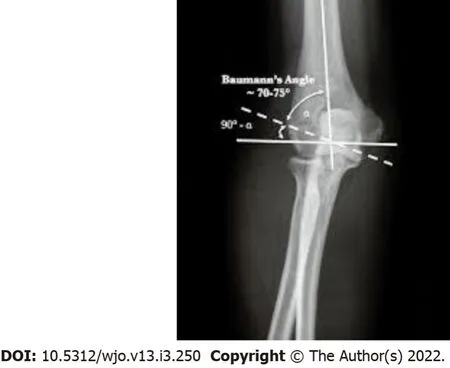
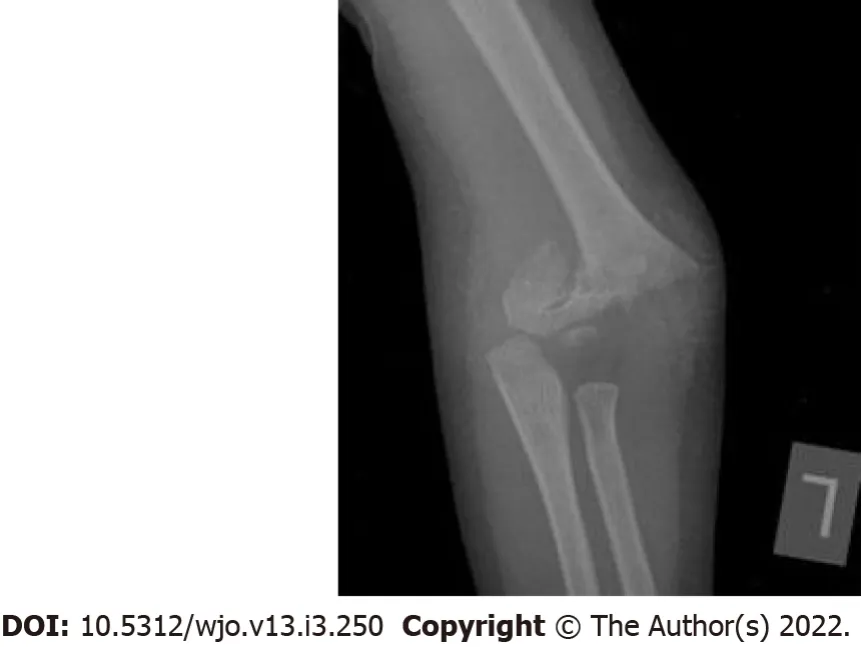
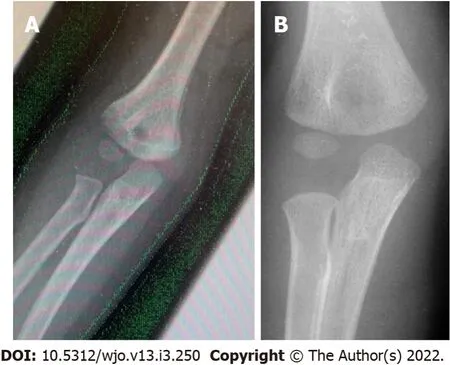
A randomized controlled trial involving larger samples and evenly distributed cases with long-term follow-up is warranted in future studies.
A retrospective analysis was performed on 101 patients who were surgically managed by either one of the CRPP techniques from 2015 to 2019.Several clinical parameters were taken into account,including pre- and post-intervention Baumann's angle,as well as scores for pain,range of motion,function,and stability.Statistical analyses were performed to study the outcomes of the utilized techniques.
All of our patients were eligible to participate in our study.Matching by age and gender was not performed due to the small number of patients in the crossed pinning group and the portability of introducing bias.Case selection bias was minimal because we applied strict inclusion and exclusion criteria,and the outcome of interest was clear for all categories.In addition,information bias was controlled by excluding all patients with missing information.
Data was entered and analyzed using IBM SPSS statistics version 23.We looked at MEPS,Gartland type,type of fixation,and Baumann angle.We classified the patients according to the technique used(crossed pinninglateral pinning);the lateral pinning group was further sub-classified into 2 pins3 pins.Patients were also categorized according to Gartland type,MEPS score,and gender.Using thetest,we measured if there was a difference in Baumann angle according to the type of fixation,and whether it was lateral pinning or crossed pinning.Using multiple linear regression,we measured the factors that affect Baumann angle and MEPS.Using ANOVA,we measured if there was a difference between two lateral pins,three lateral pins,and crossed pinning groups in their effect on Baumann angle and MEPS.Results were considered significant at<0.05.
The Prince asked him if he were hungry, and when the wolf said he was, he got down from his horse and said, If you are really as you say and look, you may take my horse and eat it
RESULTS
A total of 101 patients with supracondylar fractures were qualified to join our study.All patients responded and were included in the analysis.Of these patients,63(62.4%)were male,and 38(37.6%)were female.The mean age of patients was 5.87 ± 1.5 years,with the youngest patient being 35 d of age and the eldest being 13.0 years of age.
But I tell you what. If you want to buy five of them, I won t complain too loudly about that. You can t expect me to give up all my wonderful sculptures to some stranger who left a 60 foot crane in my back yard.
We subdivided them by type of fixation into a cross pinning group with 28 patients(28.7%)and a lateral group with 72 patients(71.3%).Patients were further subdivided by Gartland type and MEPS(Table 1).As for Gartland type distribution,none had type I,21(20.8%)had type II,43(42.6%)had type III fractures,28(27.7%)had type IV,and 9(8.9%)had flexion type supracondylar fracture.The mean time for the last follow-up was 24.65 and 20.55 mo in the lateral pinning and cross pinning groups,respectively.
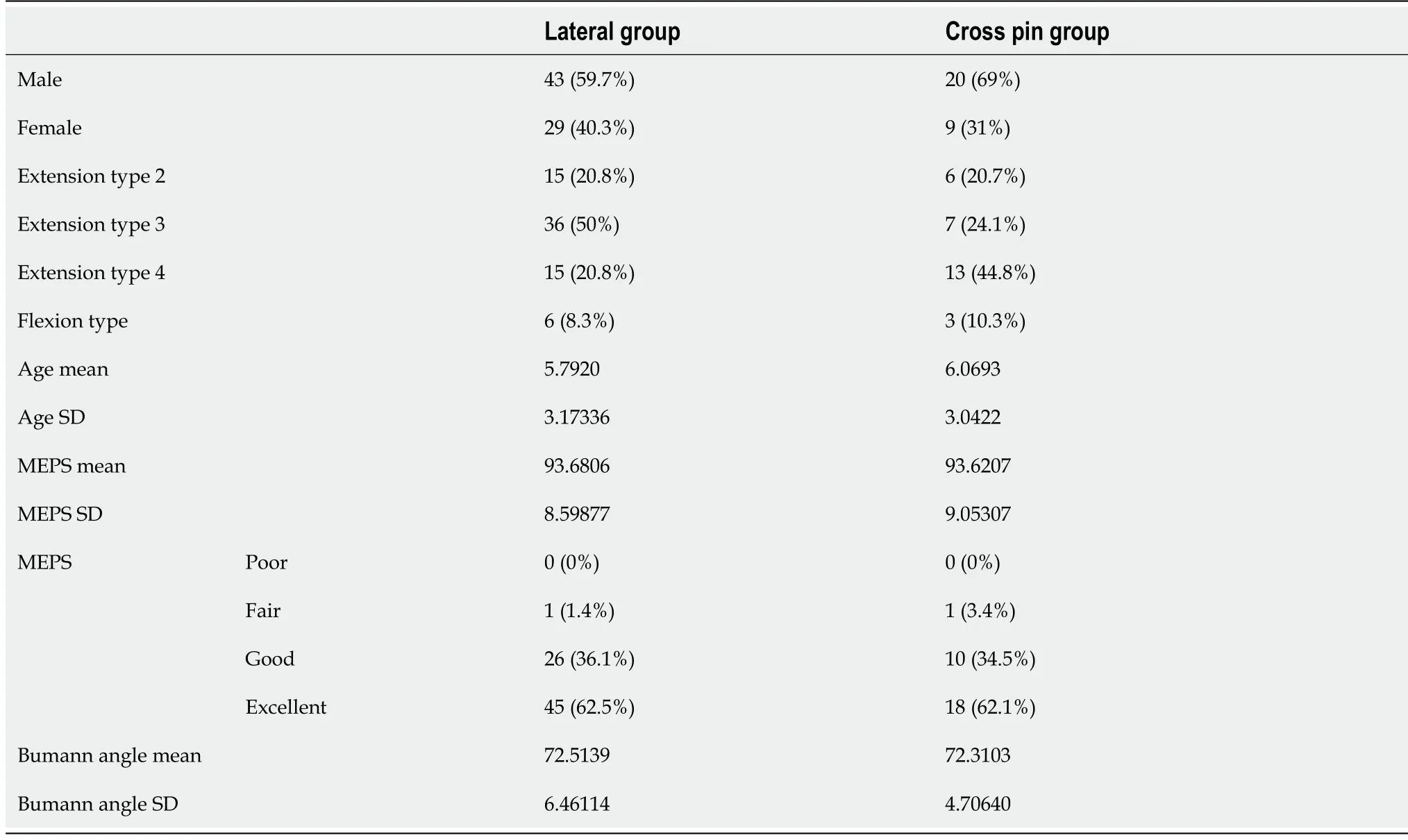
Regarding outcomes in the lateral pinning group,62.5% of the patients had excellent outcomes,36.1%had good outcomes,and 1.4% had fair outcomes.There were no reports of poor outcomes.Meanwhile,in the crossed pinning group,62.1% of patients had excellent outcomes,34.5% had good outcomes,and 3.4% had fair outcomes with no reports of poor outcomes.
Amongst our study sample,which included 63 males and 38 females with a mean age of 5.87 years,about one-third of the patients underwent crossed pinning fixation configuration and the remaining two-thirds were managed by lateral pinning configuration.Similar results were obtained in the two groups with no statistical difference regarding Mayo elbow performance scores(MEPS)and Baumann's angle.The mean MEPS in the lateral and crossed pinning groups were 93.68 + 8.59 and 93.62 + 9.05,respectively.The mean Baumann's angle was 72.5 + 6.46 in the lateral group and 72.3 + 4.70 in the crosspinning group(= 0.878).
There was no statistical difference between the groups according to Baumann angle(= 0.878).The means in the lateral pinning and crossed pinning groups were 72.5° ± 6.5 and 72.3° ± 4.7,respectively.Multiple linear regression analysis was also performed with Baumann angle with no result of statistical difference regardless of gender(= 0.115),fracture type(= 0.949),and type of fixation(= 0.995).
The Captain stopped his mules in front of Ali Baba s house, and said to Ali Baba, who was sitting outside for coolness: I have brought some oil from a distance to sell at to-morrow s market, but it is now so late that I know not where to pass the night, unless you will do me the favor to take me in
DISCUSSION
The management of pediatric supracondylar humeral fractures includes non-operative and operative treatments.Fractures are further individualized based on the presentation(open or closed fracture),Gartland classification,the degree of the displacement,and the physician preference[5,7,10].Regarding operative treatments,CRPP is the mainstay of treatment for displaced extension type supracondylar fracture.However,controversy regarding the optimal technique,whether lateral pinning or crossed pinning,remains under discussion[7,15,16].
In this study,we retrospectively evaluated 101 patients;some managed by crossed pinning(27.8%)and others by lateral pinning(72.1%[2 pins in 50% and 3 pins in the remaining 50%]).Supracondylar fracture incidence was higher in males,nearly 2 times more than in females.The mean age was 5.87,ranging from 35 d to 13 years,with a peak incidence of 5-7 years.This result is comparable to the series done by Patel[17],where they reported a peak incidence in the 6-8-year-age group with an average age of 7.48 years.Also,male predominance was noted in Patel[17],Wilkins[18],and Solak[19]series.Most clinical and radiological studies used Baumann angle,Flynn grade,and fracture complications to assess clinical outcomes[20].In our study,we used the MEPS and Baumann angle for this purpose.There was no statistically significant difference between the treatment groups.
The loss of reduction in our study was 0%.In a recent meta-analysis done by Dekker[20]comparing the two techniques,the loss of reduction occurred in 11.6% of patients treated by crossed pinning and 12.4% of patients treated with lateral pins.Yet,there was no statistically significant difference between the two groups.In addition,there was no significant difference according to the Flynn criteria,ROM,and measures of radiographic outcome.
Patel[17]also used MEPS for comparing lateral and crossed pinning technique outcomes.For the crossed pinning group,they reported that 90% of the patients had excellent outcomes,10% had good outcomes,and 0% had poor outcomes.Lateral pinning showed 83.33% excellent and 16.66% good outcomes with no reports of poor outcome.While in our study,62.5% of the patients in the lateral pinning group had excellent outcomes,36.1% had good outcomes,and 1.4% had fair outcomes with no poor outcomes.Crossed pinning showed 62.1% excellent outcomes,34.5% good outcomes,and 3.4% fair outcomes.Both studies showed no statistically significant difference between the two treatment groups.It could be that the difference in the percentages is due to the difference in the interpretation of the MEPS,as 15 points were considered a clinically negligible difference.
In a narrow creek28 she found a whole troop of little human children, quite naked, and sporting about in the water; she wanted to play with them, but they fled in a great fright; and then a little black animal came to the water; it was a dog, but she did not know that, for she had never before seen one
Several biomechanical studies demonstrated that crossed pinning is more stable than lateral pinning,especially on rotational testing and valgus and varus loading[21-23].On the other hand,other studies reported no statistically significant differences radiologically and clinically between the two groups[15,16].Although crossed pins seem to provide more stabilization,their major disadvantage is the iatrogenic ulnar nerve injury.The studies estimated it to occur 3 to 5 times more than lateral pins alone[15,16,20].Conversely,Chen[24]reported no significant difference in the biomechanical stability between divergent lateral pins and crossed pins in terms of resisting varus,internal rotation,and extension forces.Also,Hamdi[25]suggested that two or three divergent lateral pins provide optimal fracture stability.These studies support the concept that properly placed lateral pins provide adequate biomechanical stability.
But when the spring began, and the light grew longer, the hearts of the villagers leapt at the sight of the sun, and a day was fixed2 for the boats to be brought out, and the great nets to be spread in the bays of some islands that lay a few miles to the north
The limitations of our study include it being a retrospective study,not a randomized prospective clinical trial.Another major limitation was the uneven number of cases in each group in addition to them only being followed for short intervals.Furthermore,we included patients with flexion type supracondylar fractures,and these patients may constitute a different population from those with the extension type.Moreover,we did not analyze or report complications.Thus,a randomized controlled trial involving larger samples and evenly distributed cases with long-term follow-up is warranted in future studies.
But when the first rays of the rising sun fell on the garden, he saw the ten sacks all completely filled, standing there in a row, and not a single grain missing
We further subdivided the lateral group into 2 wires lateral(36 patients)and 3 wires lateral(36 patient)groups;there was no statistically significant difference between the three groups using one-way ANOVA according to MEPS(= 0.694)and Baumann angle(= 0.115).
CONCLUSION
Within the limitations of our study,the two techniques for displaced pediatric supracondylar humeral fractures promote similar postoperative results.There is no significant difference between lateral and crossed pinning techniques regarding the functional and radiological outcomes.
ARTICLE HIGHLIGHTS
Research background
In order to compare the two techniques,the well-validated Mayo elbow performance score(MEPS)was used as a standardized functional outcome measure[13,14].Other measures with clinicalradiological value may be considered as well.These may include measurement of Baumann angle(Figure 2),carrying angle,the development of complications,and the necessity to re-operate.
Research motivation
To compare the functional and radiological outcomes of lateral and cross pinning in the management of humeral supracondylar fracture.
Research objectives
To compare the functional and radiological outcomes of lateral and cross pinning in the management of humeral supracondylar fracture.
Research methods
MEPS was used to assess functional limitations of the elbow on daily activities and administered during January-March 2020patient interviewing and physical examination in the clinic.Elbow function was measured across four domains:Pain(45 points),ROM(20 points),stability(10 points),and daily function(25 points).Clinical information from these four subscales was rated on a 100-point scale and categorized as follows:<60,poor;60-74,fair;75-89,good;and 90-100,excellent[13,14].
Research results
There was no statistical difference in functional outcome according to MEPS(= 0.06).The mean MEPS in the lateral pinning and crossed-pinning groups were 93.68 ± 8.6 and 93.62 ± 9.0,respectively.Multiple linear regression analysis was performed to determine the relationship between MEPS and different clinical parameters for functional outcomes.However,there was no statistical difference found in functional outcome regardless of gender(= 0.220),fracture type(= 0.647),and type of fixation(=0.888).
Research conclusions
Both lateral pinning and crossed pinning fixation configuration for displaced pediatric supracondylar humeral fractures provide similar functional and radiological outcomes.
Research perspectives
All fractures were also assessed by altering their Baumann angle,which was measured both postoperatively and during the last follow-up in January-March 2020.Baumann angle refers to the angle between the long axis of the humeral shaft and the growth plate of the lateral condyle.A difference in the angle of more than 5 degrees between the two limbs was considered abnormal.All measurements were performed by a single calibrated examiner.The interclass correlation coefficient for the angle measurement was above 90%.
FOOTNOTES
Radaideh AM,Rusan M,Mohaidat ZM,Sunallah AW,and Obeidat O designed the research;Radaideh AM,Rusan M,Mohaidat ZM,Sunallah AW,Obeidat O,Al-Nusair J,and Albustami IS performed the research;Obeidat O analyzed the data;Obeidat O,Al-Nusair J,and Albustami IS wrote the paper.
This work was approved by the institutional review board(IRB)committee of King Abdullah University Hospital(KAUH).
Radaideh,Rusan,Obeidat,AL-Nusair,Albustami,Mohaidat and Sunallah declare that they have no conflict of interest.
The original anonymous dataset is available on request from the corresponding author at ahmadmr1970@yahoo.com.
They will go out into the world and rule over poultry4 yards of their own; but this poor little fellow will always have to stay at home with his mother
This, however, he also got used to, when he saw that they could never hit him, and in this way he flew about all that year, until the troll called him home again, said some strange words to him, and gave him his human shape again
The authors have read the STROBE Statement—checklist of items,and the manuscript was prepared and revised according to the STROBE Statement—checklist of items.
This article is an open-access article that was selected by an in-house editor and fully peer-reviewed by external reviewers.It is distributed in accordance with the Creative Commons Attribution NonCommercial(CC BYNC 4.0)license,which permits others to distribute,remix,adapt,build upon this work non-commercially,and license their derivative works on different terms,provided the original work is properly cited and the use is noncommercial.See:http://creativecommons.org/Licenses/by-nc/4.0/
Jordan
Ahmad M Radaideh 0000-0003-1556-9972;Mohammad Rusan 0000-0002-1888-0398;Omar Obeidat 0000-0003-2847-1309;Jowan Al-Nusair 0000-0002-7183-5940;Iyad S Albustami 0000-0001-8923-8485;Ziyad M Mohaidat 0000-0003-0474-2645;Abdulkarim W Sunallah 0000-0002-5553-6529.
The powerful contrast between God s way of treating people and Death s manner of making no distinctions based on social class reflected growing skepticism about the comforts of religion. Social justice would have to come through means other than piousness27 and prayer. (196)
American Academy of Orthopedic Surgeon;Royal College of Surgeons(Ireland).
15. Belongs to King Thrushbeard: Jack53 Zipes in his translation gives the follower57 rhyme which expresses the conversation between the daughter and the fiddler when reaching the forest, town, and meadow. The daughter speaks first.
Wang LL
Wang TQ
Wang LL
 World Journal of Orthopedics2022年3期
World Journal of Orthopedics2022年3期
- World Journal of Orthopedics的其它文章
- Patient-specific instrumentation in total ankle arthroplasty
- Diagnosis,treatment and complications of radial head and neck fractures in the pediatric patient
- Conservative treatment of knee osteoarthritis:A review of the literature
- Accuracy of shoulder joint injections with ultrasound guidance:Confirmed by magnetic resonance arthrography
- Ilizarov bone transport combined with the Masquelet technique for bone defects of various etiologies(preliminary results)
- Comparative study of intertrochanteric fracture fixation using proximal femoral nail with and without distal interlocking screws
